Yes, I can be a nerd. Especially when it comes to equipment and accessories.
I like to think through every detail of my equipment and I love to go shopping for it and try out everything that the industry offers in terms of clever solutions for expensive money…
Page Contents (click line to jump the text)
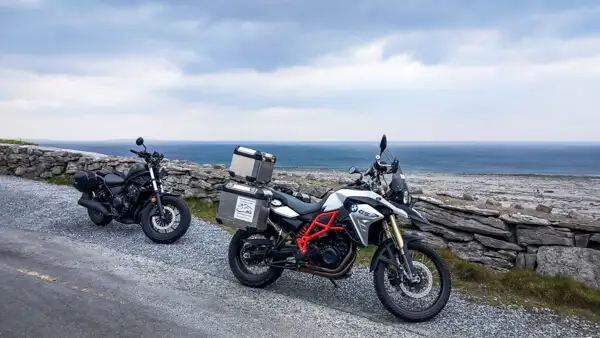
Intro
Do you have to do it like that? Not at all!
Less is more – this is true for hiking, cycling and also for motorbike tours. A motorbike world traveller (I’ve unfortunately forgotten the name) once said:
“I have never wished to have more engine power, but I have often wished to have less weight on the bike”.
I’m getting there more and more, too. But there are a few sensible things that will help you on your journey, and I want to share them with you from my point of view:
Which motorbike is suitable for a trip to Ireland?
A slightly older Irish motorcyclist told me that he recently went on a tour of the Wild Atlantic Way with a group of friends. Most of them rode big machines. Only one young rider rode a small 125cc bike – everyone was amazed, but the boy had no problem at all keeping up with the group!
I was not surprised to hear that.
In Ireland, basically any bike works and most importantly, engine power doesn’t matter at all. I repeat again, because nobody wants to believe me (especially in Germany):
Engine power doesn’t matter at all in Ireland!!!
It is much more important that you can turn the loaded bike on narrow roads without any problems, that you can drive a section of road with rolling gravel without fear and that you can drive safely onto a gravelled car park – and back down again.
To do this, you should be able to stand with both feet fully on the ground (not on tiptoe) and hold the bike securely even on slippery ground.
It is important that you have good control of your bike and that it is comfortable for you. I see riders all the time in Ireland who ride machines that are too big and too heavy and then get into trouble.
How do I know this? I run a motorbike rental company in Ireland (update: I did for number of years…) and ride a lot on the island myself. We also offer nice guest rooms.
What awaits my motorbike on the trip? Route and conditions
Country roads in Ireland are generally very narrow, bends are often impossible to see because of hedges and walls, and the road surface is often not good. There are bumps and potholes and lots of rolling gravel from road construction.
On the Atlantic coast, there are always wonderful little roads leading through the mountains. Often they are only one lane and then there are passing bays for oncoming traffic. As a motorcyclist, you often have to hug the (uneven) side of the road to let a tractor or similar through.
Because of the bumps, a good suspension makes sense (smaller or medium touring enduro), but any other motorbike (cruiser or sporty) will work as well if you go appropriately slow.
But I still need my 150 hp for the motorway approach!!!!
Every country you drive through has a speed limit on the motorway (only Germany embarrassingly doesn’t). And almost every motorbike can do 120-130 km/h. The 125cc might only just, but what’s the problem? The 125cc might only just, but what’s the problem?
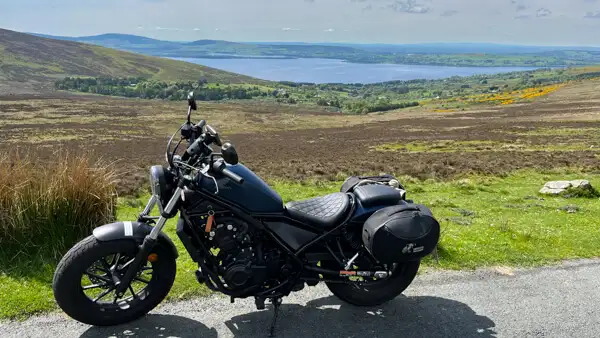
OK, enough of the eternal discussion about horsepower. If you’re looking for a good touring bike, maybe as a 2nd bike, but don’t want to spend too much money, you can find lots of great used mid-sized touring enduros and crossover bikes for sale from private sellers (Ebay classifieds or Mobile.de).
Often these are well-maintained garage vehicles with good equipment and few kilometres.
Hot tips: BMW F700GS, Honda CB500X, Suzuki VStrom650, Yamaha Tracer 700, Kawasaki Versys 650 and similar models…
Is the motorbike well maintained?
Maintenance schedule and additional checks
With the journey to Ireland, the trip to Ireland and the return journey, you will have travelled a few thousand kilometres, let’s say 1250km to Ireland, another 1250km to Ireland and 3500km in Ireland. That quickly adds up to 6000km.
When was your last oil change? Is the brake fluid still good, or do the brakes already feel a bit spongy? Are the brake pads still good enough? How do the chain and sprockets look? Can you lift the chain off the sprocket?
Maybe it makes sense to bring forward the next service? Also check all lights, indicators, horn etc. as the engineer at the TÜV would do. We’ll talk about the tyres later.
Should I take spare parts with me? Which ones can’t I get locally?
Ireland is an island and logistics can take a while longer than we are used to in Germany.
There are also not dealers for every motorbike brand there. But the big brands are represented. At least in Dublin.
If you ride a lesser brand of motorbike, there may not be any spare parts for your bike in Ireland. In that case, think about what you might need on the road and you might want to take that very rare fuse, bulb or spark plug with you (or replace it beforehand).
Motorbike tyres – which ones to choose for the Ireland tour?
Well, that has a lot to do with the road conditions: you will find rolling gravel, dirt or gravel on and off the road in Ireland more often than at home. That’s why tyres with a higher profile make a lot of sense in Ireland, even if you don’t ride off-road.
We have a motorbike rental company in Ireland (www.easycruiser.tours). Because of the road conditions described above, we fit 80/20 tyres to all our touring enduros as soon as the original tyres (mostly road tyres) are worn out.
We have had very good experiences with Mitas E08 for light/medium touring enduros and with Metzeler Karoo Street for medium/heavy touring enduros. Of course, the cruisers don’t get touring enduro tyres, but we at least make sure they have good tread and change them in good time.
Scramblers usually already have very suitable tyres. If you ride a sport tourer or roadster, you can certainly find a good rain-touring tyre, they also have a bit more tread.
And if you have 6000km to go, you should definitely start your journey with new (or fairly new) tyres.
Chains, chain oiler and chain lubricants on the road.
I don’t need that, I have a cardan (shaft drive).
The Kardan also needs to be greased occasionally – perhaps before the journey?
But all chain riders really do need to take more care of their motorbike.
There are frequent travellers who swear by chain oilers. These can be connected either to the motorbike battery or to the vacuum system and automatically oil the chain from a reservoir while riding. You may need to carry a small bottle of oil with you to refill the reservoir, but that’s it for now.
If you use chain spray, you should have a spray bottle with you. Since you’ll be spraying outdoors, and you don’t want the spray to get on the brake pads, check the wind direction before you start! You may also want to bring a piece of cardboard to put underneath and use as a “mist trap”. Pizza cardboard is also good – and you can get it at any takeaway!
The chain set should not be too old and you may want to clean and grease it thoroughly before setting off.
You will need to adjust the chain slack before the trip – and several times during the trip. Remember to take the right tools with you.
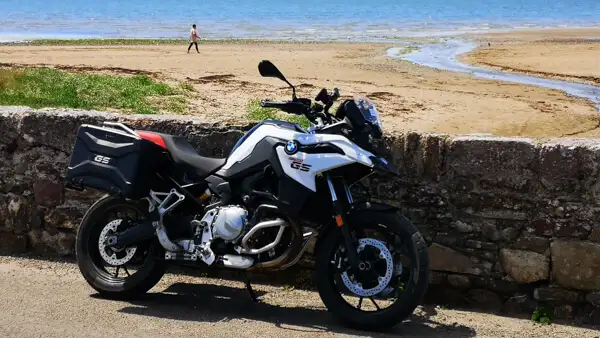
Have you thought about the battery?
The battery is usually forgotten, but it tends to cause problems. There’s hardly a ferry trip without some car or motorbike not starting. Were the lights on? Was the alarm system on the whole time?
The first question is: How old is the battery? Does the bike still start well, or do you want to quickly install a new one? You can have the remaining battery capacity tested at any garage – or maybe a friend has a battery tester.
Which consumers are connected to the battery – mobile phone charging cable, GoPro charging cable, navigation system, heating waistcoat, TV, coffee machine, ….? Do you reliably switch off the consumers as soon as the engine is switched off?
If you ever need a jump start, can you reach the battery or do you need tools? On some motorbikes the battery is difficult to reach, but there is an external connection (positive pole) for the jump start. Do you know how to do this on your bike?
If you are riding with a group, it might make sense for one of you to pack a jump-start booster. You can find them in any DIY store, they don’t cost much and apart from battery jump-starting they can also charge mobile phones or other electronics and often have a torch built in.
Motorbike tools – how much to take and when is it too much?
I wouldn’t overdo it at this point, because you’ll find a garage in every small town in Ireland where they’ll be happy to help you out for a few euros.
But it makes sense to take a few things with you:
The necessary tools to adjust the chain, one or two spanners for the mirrors, a few cable ties and duct tape or insulating tape to temporarily fix loose parts, Allen or Torx keys to adjust the handlebars, the necessary tools to access the battery, a small pair of pliers and screwdriver, maybe a pocket knife.
All this fits easily into a small luggage roll and that should be enough for now. There are also small tool rolls ready to buy and with these you have most of the tools with you.
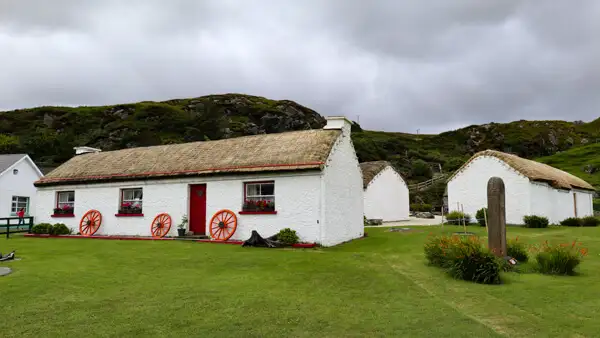
Roadside assistance, first aid and high-visibility vests
In Ireland, Scotland and England, you see many motorcyclists, but also cyclists or joggers wearing high-visibility waistcoats.
Better visibility is better. In France, even motorcyclists have to carry a high-visibility waistcoat with them – it weighs almost nothing, takes up hardly any space – pack it and you’re done.
A nail or a screw in the tyre is more common than you might think, especially in Ireland. A tyre repair kit for tubeless tyres, or a tyre repair spray for tubular tyres will help you get to the next overnight stay or to the next town in case of a puncture.
A small compressor with a rechargeable battery or a cable to connect it to the battery also helps enormously – in a group, you can distribute the equipment over several riders. A small hand or foot pump is also an alternative.
Of course, a first aid kit should not be missing from your luggage!
Luggage – optimise as a system
This is not about whether aluminium suitcases, plastic suitcases or soft luggage are better. I leave that entirely up to your taste.
But in general you should think about the weight distribution. If you load all the luggage on top and in the back, the front wheel becomes very light, the rear wheel very heavy and the centre of gravity is very high. Even worse with a passenger. The bike then becomes very wobbly and unstable!
Better: Distribute the weight evenly, as low as possible and as central as possible, then the motorbike remains quite stable even when loaded and much easier to manoeuvre.
For this reason alone, side panniers or side bags make a lot of sense. If you’re riding with a passenger, a tank bag also makes a lot of sense, but don’t load a bag on top of the top case – that puts the weight too far back and too high.
When packing, load all heavy things (tools,…) as low as possible and the light things on top. The left and right side cases should be of similar weight in the end, then you have already done a lot right.
How about the Windscreen?
If you want to travel for hours on the motorway and your motorbike does not have a windscreen, you can also fit a windscreen before the journey. These are available in many shapes and sizes in the accessories section.
Because of the height, I recommend either a windshield up to the sternum or up to the chin. You don’t want to look through the windscreen because flies or rain will make it impossible to see. If the visor is chest high, it may throw air vortices directly at the helmet (hence lower or higher).
However, hours of air hitting the helmet is worse and more uncomfortable than no wind protection. If your windshield height doesn’t fit, you can screw or clamp an adjustable spoiler on top, that also helps.
Crash bar and hand lever protection
Gravity works reliably, even on holiday! In a harmless crash, the brake lever breaks off or the clutch lever, and a minor problem becomes a showstopper!
Many – even very expensive – touring enduros today are delivered with plastic hand guards – these things are only good for wind protection, they break in a crash and the hand levers bend or break anyway!
It makes a lot of sense to fit hand guards made of sturdy metal, if necessary with plastic hand guards in front. The latter keep the hands warm and dry.
If you have a motorbike for which hand guards are not an option, there are special hand levers with a joint that can be replaced. They fold to the side in the event of a fall and thus remain intact in most cases.
Or there are handlebar end guards. These are half brackets that are bolted to the end of the handlebars at one point only and protect the end of the hand lever.
Side crash bars on the motorbike that protect the engine and tank are also a good investment.
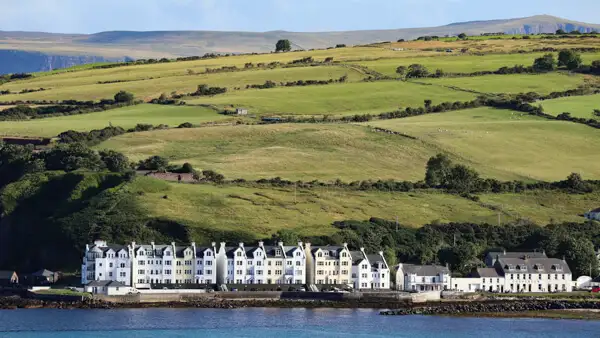
On the ferry – a few tips
It gets wet, salty and slippery on the ferry. Especially when entering and leaving the ferry, you should proceed slowly and carefully. Don’t accelerate or brake or steer jerkily, the steel floor could be slippery.
Motorbikes are usually parked against a wall or kerb and placed on the side stand. Make sure that the front wheel, which is turned to the left, is firmly against the front obstacle. Put the handlebar lock in so that the front wheel remains stationary. Keep 1st gear engaged so that the rear wheel does not roll.
Usually a wide ready-made tension belt is placed over the seat. There are pads or pieces of carpet that you can place underneath so that the tension belt does not damage the seat. The strap is hooked into ground eyelets on the left and right of the motorbike and tightened. Ask other bikers or the crew to help you.
Sometimes rubber wedges are placed under the wheels and, if necessary, under the engine block to prevent bobbing.
You can bring a short piece of Velcro or a tensioning strap and fix the handbrake lever with it.
If you don’t want to do that, you can alternatively take a quick and cheap flight to Dublin and rent a motorbike from us: www.easycruiser.tours.
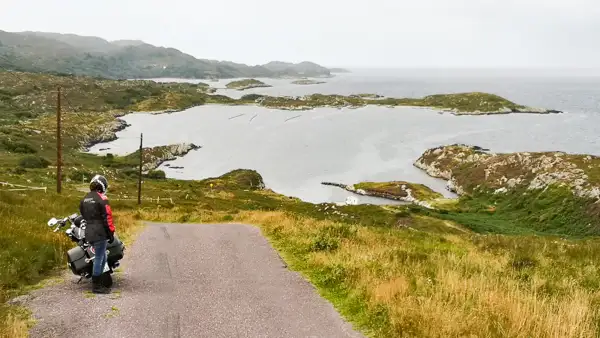
Back from the trip – final maintenance
Ireland is an island. You will arrive by ferry and drive quite a few stretches of coast, maybe even the whole Wild Atlantic Way. Then again on the way back.
Your bike will get more or less salt, because the air by the sea is always salty.
Salt promotes rust on all open metal parts. Brake discs, chrome parts, screw heads, spoke screw nipples – you will find many parts that will rust faster than usual.
After the tour, it therefore makes sense to “bathe” the motorbike intensively with a garden hose or a high-pressure cleaner set to “mild”. Get into all the crevices, including under the bike, but be careful not to get directly on the wheel bearings or the swingarm bearings.
Shampoo thoroughly, clean with a soft cloth and then rinse thoroughly with clean water.
After so much water, you will want to clean and oil the chain and treat critical metal parts with a maintenance oil.
You may also want to look over the tyres, brake pads and all the lights to see if there were any “trouble spots” during the trip.
Your “sweetheart” will thank you for it and will be happy to accompany you on your next trip – and I’d love to go to Ireland again, because it was so beautiful there! 🙂 And if you would prefer to rent a lovingly maintained motorcycle, then you can do so here: https://www.easycruiser.tours.
Have fun and enjoy the ride!
More interesting articles for you
HOW CAN I PREPARE AS A RIDER FOR THE IRELAND MOTORBIKE TRIP?
56 TIPS FOR PLANNING AN UNFORGETTABLE MOTORBIKE TRIP TO IRELAND!
MOTORBIKE TOUR AND GLAMPING IN IRELAND – 10 GREAT TIPS FOR YOUR WILD ATLANTIC WAY TOUR
LEFT-HAND TRAFFIC – WHAT SHOULD I KNOW AS A MOTORCYCLIST?
Photo credits cover photo: Motorcycle at a sea bay in northwestern Ireland, photo by Ulrich Knüppel-Gertberg (www.irland-insider.de, www.ireland-insider.com)